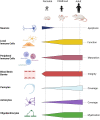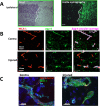Brain Maturation as a Fundamental Factor in Immune-Neurovascular Interactions in Stroke
- PMID: 36705821
- PMCID: PMC10796425
- DOI: 10.1007/s12975-022-01111-7
Brain Maturation as a Fundamental Factor in Immune-Neurovascular Interactions in Stroke
Abstract
Injuries in the developing brain cause significant long-term neurological deficits. Emerging clinical and preclinical data have demonstrated that the pathophysiology of neonatal and childhood stroke share similar mechanisms that regulate brain damage, but also have distinct molecular signatures and cellular pathways. The focus of this review is on two different diseases-neonatal and childhood stroke-with emphasis on similarities and distinctions identified thus far in rodent models of these diseases. This includes the susceptibility of distinct cell types to brain injury with particular emphasis on the role of resident and peripheral immune populations in modulating stroke outcome. Furthermore, we discuss some of the most recent and relevant findings in relation to the immune-neurovascular crosstalk and how the influence of inflammatory mediators is dependent on specific brain maturation stages. Finally, we comment on the current state of treatments geared toward inducing neuroprotection and promoting brain repair after injury and highlight that future prophylactic and therapeutic strategies for stroke should be age-specific and consider gender differences in order to achieve optimal translational success.
Keywords: Blood–brain barrier; Childhood arterial stroke; Choroid plexus; Inflammation; Neonatal stroke.
© 2022. The Author(s).
Conflict of interest statement
The authors declare no competing interests.
The authors declare no competing interests.
Figures




Similar articles
-
Immune-Neurovascular Interactions in Experimental Perinatal and Childhood Arterial Ischemic Stroke.Stroke. 2024 Feb;55(2):506-518. doi: 10.1161/STROKEAHA.123.043399. Epub 2024 Jan 22. Stroke. 2024. PMID: 38252757 Free PMC article. Review.
-
Pathophysiology and neuroprotection of global and focal perinatal brain injury: lessons from animal models.Pediatr Neurol. 2015 Jun;52(6):566-584. doi: 10.1016/j.pediatrneurol.2015.01.016. Epub 2015 Jan 31. Pediatr Neurol. 2015. PMID: 26002050 Free PMC article. Review.
-
Mechanisms of perinatal arterial ischemic stroke.J Cereb Blood Flow Metab. 2014 Jun;34(6):921-32. doi: 10.1038/jcbfm.2014.41. Epub 2014 Mar 26. J Cereb Blood Flow Metab. 2014. PMID: 24667913 Free PMC article. Review.
-
Microglia-leucocyte axis in cerebral ischaemia and inflammation in the developing brain.Acta Physiol (Oxf). 2021 Sep;233(1):e13674. doi: 10.1111/apha.13674. Epub 2021 May 30. Acta Physiol (Oxf). 2021. PMID: 33991400 Free PMC article. Review.
-
Barrier mechanisms in neonatal stroke.Front Neurosci. 2014 Nov 7;8:359. doi: 10.3389/fnins.2014.00359. eCollection 2014. Front Neurosci. 2014. PMID: 25426016 Free PMC article. Review.
Cited by
-
The Triad of Blood-Brain Barrier Integrity: Endothelial Cells, Astrocytes, and Pericytes in Perinatal Stroke Pathophysiology.Int J Mol Sci. 2025 Feb 22;26(5):1886. doi: 10.3390/ijms26051886. Int J Mol Sci. 2025. PMID: 40076511 Free PMC article. Review.
References
Publication types
MeSH terms
Grants and funding
LinkOut - more resources
Full Text Sources
Medical
